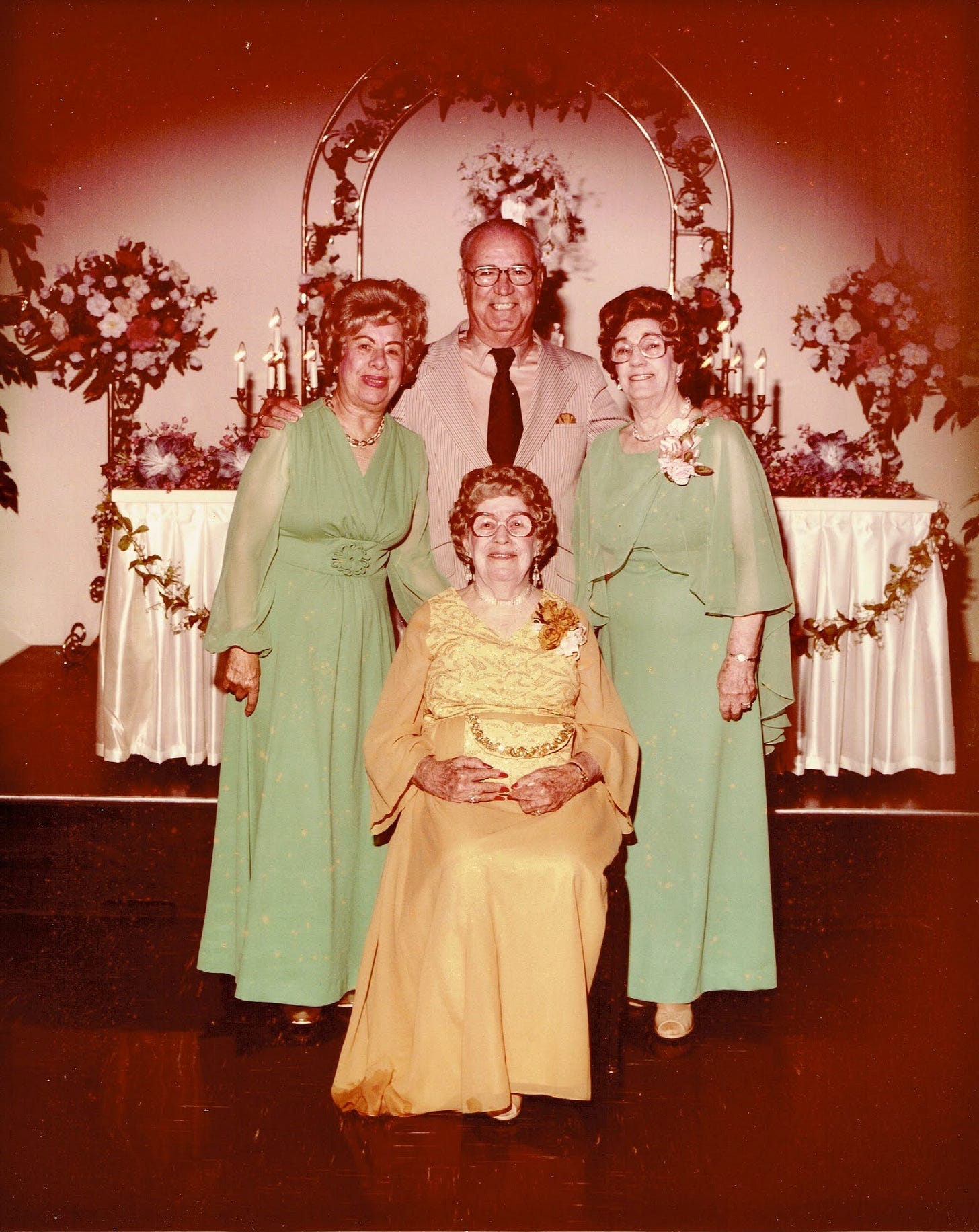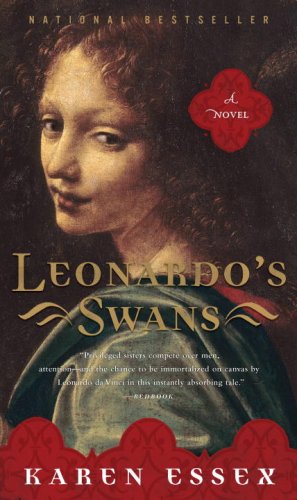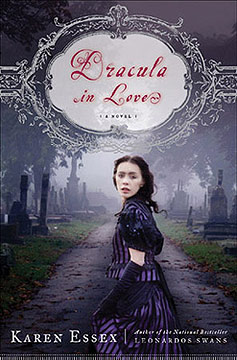Welcome to History. Sex. Power.
Where power wears perfume, seduction builds empires, and survival is a work of art.
Where power wears perfume, seduction builds empires, and survival is a work of art.
Meet my grandmother, Frances (top right), and great aunts Josie (center) and Emily (top left), on their way to a Mardi Gras ball, all adorned in their prized Eva Gabor wigs! (Great Uncle Vincent was basically their late in life chauffeur.

These Italian ladies’ food was legend (below, my grandmother’s recipe for stuffed artichokes) and so was their gossip, completely uncensored for my eager young ears. I grew up in their kitchens, hearing their excited chatter about the escapades of the glamorous, scandalous Gabor sisters—their fashions, jewels, romances and (many, many) husbands. Sadly, my ancestresses died not knowing that they were shaping me as a writer.
 On a trip to Milan, I visited The Last Supper, which can only be seen by appointment and in small groups. After everyone had left the room, I remained, strangely drawn to the mural on the opposite wall, the Crucifixion scene by Giovanni Montorfano. In the lower right corner, witnessing the Crucifixion, are several Dominican nuns. This caught my eye, having been educated by the Dominicans in New Orleans. Who, I wondered, was the ghostly figure kneeling in prayer, virtually nestled in the skirts of the nuns?
On a trip to Milan, I visited The Last Supper, which can only be seen by appointment and in small groups. After everyone had left the room, I remained, strangely drawn to the mural on the opposite wall, the Crucifixion scene by Giovanni Montorfano. In the lower right corner, witnessing the Crucifixion, are several Dominican nuns. This caught my eye, having been educated by the Dominicans in New Orleans. Who, I wondered, was the ghostly figure kneeling in prayer, virtually nestled in the skirts of the nuns?
While the rest of the mural is in fine condition, the figure of the kneeling woman has all but disappeared. Being someone who unearths women’s hidden history, I had to find out more. Upon further investigation, I discovered that it was Beatrice d’Este, the young wife of Ludovico, the infamous duke of Milan and Leonardo’s patron. I also found out that it was Leonardo who had painted Beatrice into Montorfano’s mural. Why?
More curious still, I visited the Trivulzian library in the Castello Sforzesca, but found that it was closed for renovation. I pounded on the door, finally getting a reluctant librarian to open it. In my pathetic, broken Italian, I announced that I was a novelist looking for information on Beatrice. No one in the library spoke English, and besides, did I not understand that they were closed? With some persistence, I found a sweet-faced librarian who spoke French and pleaded my case. With a bit of coaxing, she began to show me copies of exquisite miniatures of Beatrice and her children, as well as a bibliography that would be useful in finding out more about her fascinating, short life.
I found myself inexplicably moved by Beatrice’s tragic story. Later, while walking through the rooms of the Castello, I felt an eerie, chilling aliveness. I believe that all writers and journalists feel this heightened awareness when a nascent story begins to blossom within us. I dug deeper, trying to find if there was a personal connection between Beatrice and Leonardo, when I discovered that during his years in Milan, Leonardo painted not only Beatrice, the duke’s 15-year- old wife, but Isabella, Beatrice’s illustrious sister, who was the Peggy Guggenheim of her time and who was having a flirtation with the duke; Cecilia Gallerani, the duke’s 17-year-old mistress; and Lucrezia Crivelli, the duke’s later mistress. Imagine, I thought, all these women competing for supremacy in the duke’s heart, while Leonardo was charged with painting them. The poor artist! Leonardo’s troubles with the duke are well known. Didn’t he have enough on his hands without having to negotiate around the duke’s love life?
I set out to find out everything I could about the Este sisters. I dug up books about their lives, mostly from the 19th century and long out of print. I read their letters, as well as letters by the courtiers of their time. I traversed northern Italy, visiting Ferrara, where they were born, and Mantua, where Isabella reigned as Marchesa. I visited the areas around Milan where Beatrice and Ludovico kept their “pleasure palaces.” I went to Venice, where both sisters came, one after the other, competing for the favor of the Doge and the Venetian Senate. By the time I came home, the story of these formidable women and their rivalries had started to write itself.
 Of all the women distorted by history and myth, Kleopatra is the most vivid example. Far from the sexual and treacherous archetype of feminine evil who lives in the popular imagination, Kleopatra was one of the ancient world’s most brilliant and powerful rulers. She survived blood-curdling family rivalries for the throne, single-handedly ruled a rich nation with an eye for turning a profit, and kept Egypt independent while all its neighboring countries had been annexed to the Roman Empire. She spoke nine or ten languages, patronized art, drama, athletics, sciences and other forms of scholarship, and had the loyalty of her subjects — rare for the members of her dynasty.
Of all the women distorted by history and myth, Kleopatra is the most vivid example. Far from the sexual and treacherous archetype of feminine evil who lives in the popular imagination, Kleopatra was one of the ancient world’s most brilliant and powerful rulers. She survived blood-curdling family rivalries for the throne, single-handedly ruled a rich nation with an eye for turning a profit, and kept Egypt independent while all its neighboring countries had been annexed to the Roman Empire. She spoke nine or ten languages, patronized art, drama, athletics, sciences and other forms of scholarship, and had the loyalty of her subjects — rare for the members of her dynasty.
It was time to set the record straight, and it would take two books to do so. The first, KLEOPATRA, is the untold story of her astonishing young life before she ever laid eyes on Julius Caesar. The second book, PHARAOH, begins when as an exiled queen, she has the audacity to present herself to the most powerful man in the world and demand his support.
The Kleopatra handed to us by history was the victim of a smear campaign by her rival and mortal enemy, Octavian (who became Caesar Augustus). Octavian feared — with good reason — not only Kleopatra’s power as the Queen of Egypt, but also her influence with Julius Caesar, and later, Mark Antony. History is written by the winners, and Octavian, in his war against Antony and Kleopatra, won. After her death, he destroyed all written histories favorable to her, and her story was rewritten by his court historians.
The more I found out about the historical Kleopatra, the more infuriated I became over the perversion of her legacy. Women have virtually no role models who have had Kleopatra’s great power, and I could not accept the fact that perhaps the most powerful woman in history — with the possible exceptions of Queens Elizabeth I and Victoria — has been remembered only for the men with whom she slept, and has been blamed for their downfall. I began to find out as much as I could about Kleopatra, and the more I learned, the more I raged on to friends and anyone who would listen. Finally, a fellow writer — perhaps tired of listening to me — suggested that I turn my passion into a book.
Luckily, I was enrolled in an inter-disciplinary graduate program at Vanderbilt University where I could study with classicists, historians, and women’s studies scholars. I studied not only Egyptian culture, but also Greek history, Roman history, and the history of the area we now consider the Middle East because Kleopatra’s story stretches over all those lands and cultures.
I wanted people to rethink the very idea of Kleopatra, right down to the spelling of her name. Replacing the familiar “C” with the more appropriate “K,” which is from .the original Greek and how she would have spelled her name, was my first step in interrupting the traditional narrative of this extraordinary woman’s life.
I traveled to Egypt, Greece, Turkey, and Rome, walking in Kleopatra’s footsteps. The research process took five years. Only then did I begin to write the book. At the outset, I had no idea what it was going to take to do write this book with integrity!
It would be ten years from the time I decided to write about Kleopatra to the publication of the second book, PHARAOH. It was both strange and illuminating to spend a decade of my life with someone who’s been dead for two thousand years. But I hope that I’ve contributed to the ongoing dialogue about the ways in which women have been ignored, misinterpreted, or discredited by the telling of history.
For more information or to purchase the book:

Friends and readers, let me give it to you straight. I do not want to die. It’s that simple. And now that I have written a vampire book, Dracula in Love, and fully explored the advantages, I really, really thirst to be an immortal.
Oh, I am not afraid of death. I believe beyond a shadow of doubt in the immortality of the soul. I am absolutely certain that death will be a pleasant, if not ecstatic experience. I always believe that the best is yet to come, and I extend that belief to life after death. If life is good, then death will be great.